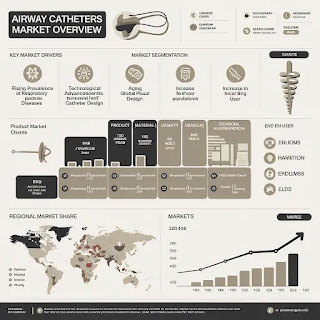The Growing Airway Catheters Market: A Critical Component of Modern Healthcare
The global airway catheters market represents a vital segment within the medical device industry, playing an indispensable role in respiratory care and emergency medicine. As healthcare systems worldwide continue to evolve and patient care becomes increasingly sophisticated, the demand for advanced airway management solutions has reached unprecedented levels.
Request a Sample: https://www.futurewiseresearch.com/contact.aspx?rpt=13151&type=requestsample
Market Growth and Financial Projections
The global airway catheters market size was valued at
approximately USD 1.5 billion in 2023 and is projected to reach around USD 2.8
billion by 2032, growing at a compound annual growth rate (CAGR) of about 7.1%
during the forecast period. This robust growth trajectory reflects the
increasing importance of airway management in clinical settings and the
continuous innovation in medical device technology.
Different market research firms project varying growth
rates, with some estimates suggesting even higher expansion potential. Airway
Catheters Market is likely to grow at a CAGR of 9.6% and is expected to reach
US$ 985.8 Million by 2033, while another analysis indicates the global airway
catheters market is expected to grow at an 8.60% CAGR, reaching US$856.5
Million by 2031 from US$480.8 Million in 2024. These variations in projections
underscore the dynamic nature of this market and its potential for significant
expansion.
Understanding Airway Catheters
Airway catheters are specialized medical devices designed to
maintain a patent airway in patients who cannot breathe independently. These
critical instruments are commonly utilized in emergency departments, intensive
care units, operating rooms, and other clinical settings where airway
management is paramount. The devices serve multiple functions, including
facilitating endotracheal tube placement, providing oxygen insufflation, and
enabling jet ventilation through their hollow design.
The versatility of airway catheters makes them essential
tools in various medical scenarios, from routine surgical procedures to
life-threatening emergency situations. Their radiopaque properties allow for
precise positioning under imaging guidance, while their hollow construction
enables continuous oxygenation during airway management procedures.
Key Market Drivers
Several factors are propelling the growth of the airway
catheters market. The increasing prevalence of respiratory disorders, including
chronic obstructive pulmonary disease (COPD), asthma, and sleep apnea, has
created a sustained demand for advanced airway management solutions.
Additionally, the growing number of surgical procedures worldwide requires
reliable airway maintenance throughout operations.
The aging global population presents another significant
driver, as elderly patients often require more complex airway management due to
age-related physiological changes and comorbidities. Furthermore, the expansion
of healthcare infrastructure in developing countries is creating new market
opportunities for airway catheter manufacturers.
Technological Advancements and Trends
The demand for disposable airway catheters is rising due to
their convenience, reduced risk of infections, and cost-effectiveness.
Manufacturers are focusing on developing disposable catheters to cater to this
growing trend. This shift toward single-use devices reflects broader healthcare
trends emphasizing infection control and patient safety.
Innovation in materials science has led to the development
of more flexible, biocompatible catheters that reduce patient discomfort while
maintaining structural integrity. Advanced coating technologies have also
improved the insertion process and reduced the risk of tissue trauma during
placement.
Applications Across Healthcare Settings
Airway catheters find extensive applications across various
medical specialties. In emergency medicine, they serve as lifelines for
patients experiencing respiratory distress or requiring immediate airway
intervention. Anesthesiologists rely on these devices during complex surgical
procedures to ensure continuous airway patency and facilitate smooth extubation
processes.
Critical care medicine heavily depends on airway catheters
for managing mechanically ventilated patients and those requiring airway
exchange procedures. The devices are also increasingly used in outpatient
settings for diagnostic procedures and minimally invasive interventions.
Future Outlook
The airway catheters market is poised for continued growth,
driven by technological innovations, expanding healthcare access, and
increasing awareness of the importance of proper airway management. As medical
professionals continue to recognize the critical role these devices play in
patient outcomes, investment in research and development is expected to
accelerate.
The integration of smart technologies, including sensors and
monitoring capabilities, may represent the next frontier in airway catheter
development. These advancements could provide real-time feedback on catheter
positioning and patient status, further enhancing the safety and efficacy of
airway management procedures.
As healthcare systems worldwide prioritize patient safety and clinical outcomes, the airway catheters market will likely continue its upward trajectory, making it an attractive sector for both established medical device companies and innovative startups seeking to improve respiratory care delivery.




Comments
Post a Comment